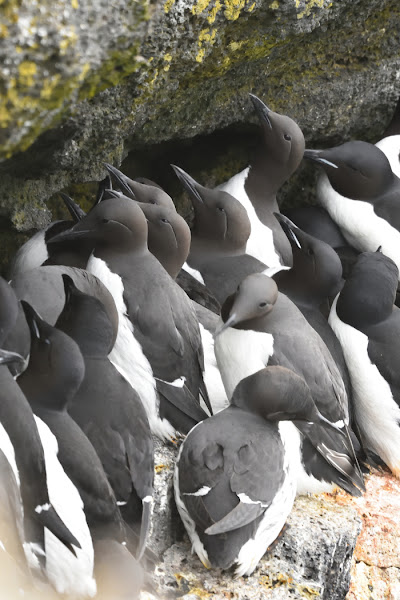The kitchen was open each morning for a continental breakfast. I had cereal and hot chocolate, which was very helpful given the cold temperatures on the island. Temps steadily remained in the 30's all week with the exception of a day or two when the sun showed itself and it reached the low 40's. The guides told us that it had been an exceptionally cold Spring and that some of the birds seemed behind schedule, especially the landbirds. There was still snow on portions of the hillsides and we had occasional snow flurries here and there. This morning was one of those times with light snow falling.
Our same group of seven, Randy Madding, Randy Cooley, Gene Keferl, Steve Calver, Charles Strehl, Anne Woods, and I climbed into a van with Luis and we drove to Ridge Wall to get our first looks at the cliff-nesting birds. My guess was that the cliffs there were about a hundred feet high. You could walk near the edge and look to each side to see the birds. We were warned not to get too close due to the instability and also in case a gust of wind caught you off guard. We knew if you went over the side you were dead or would eventually die because there was no way to get anyone there to rescue you even if you did survive the fall. On a much brighter note, the numbers and variety of birds were fantastic. Tufted Puffins showed off their streaming head plumes and a few Horned Puffins were present, too.
One section of the cliffs was tightly packed with a mixture of Common and Thick-billed Murres.
One of the reasons I wanted to go to Saint Paul was because it's one of the few places where you can see nesting Red-legged Kittiwakes. These were the first photos that I got of this life bird.
I took this comparison photo to show the main differences between Red-legged and Black-legged Kittiwakes, which also nest on the cliffs.
The Black-legged Kittiwakes also provided ample opportunities for photos.
The most common gull on the island is the Glaucous-winged Gull. One flew by below the cliffs.
Scanning birds offshore was fairly easy because the seas were very calm that morning. One of the birds seen far offshore was this Ancient Murrelet. I was able to get a distant documentation photo of this life bird.
We continued on down the road to Southwest Point. Birds flying past the point included Red-faced Cormorants, another life bird, and the much less commonly seen Pelagic Cormorant with its thin neck and head and all-dark bill.
A raft of Harlequin Ducks fed just offshore.
Our next stop was the Kamanista Quarry where we would search for landbirds, but we only found the usual Rock Sandpipers, Gray-crowned Rosy-Finches, Snow Buntings, and Pacific Wrens. I took some photos of the view from atop the back end of the quarry.
After lunch, we headed over to the Salt Lagoon and found the Ross's Gull a little closer today, so I managed to get some better photos than the two I got yesterday. Two Black-headed Gulls and a Sabine's Gull were also present.
Farther north at the Polovina Wetlands, 2 Snow Geese, which are unusual here, 3 Greater White-fronted Geese, and a Tundra Swan were seen. Four Tufted Ducks and a Tree Swallow were the notables seen at nearby Webster Lake. A pair of Garganeys and a Wood Sandpiper were at Pumphouse Lake. We quickly returned to the Salt Lagoon when a Common Greenshank was found by another group. Unfortunately, it was very skittish and flew off soon after we got there. The only photo I got of it shows the diagnostic wedge of white running up the back of the bird.
After dinner, we drove to the Antone Slough. When we parked, we noticed a herd of Caribou farther down the road.
At the Antone Slough, we found 5 Common Snipe, 2 Long-toed Stints, a Common Sandpiper, a Wood Sandpiper, 2 Pectoral Sandpipers, 3 Least Sandpipers, a Western Sandpiper, and 2 Semipalmated Plovers. I got better photos of the Common Snipe showing the white bars in the underwings.
These photos of one of the Long-toed Stints show the dark forehead and split supercilium.
I also got poor photos of the other Long-toed Stint, but they do show the pale base to the bill and the yellow legs.
After striking out the night before, I finally got some documentation photos of a Common Sandpiper.
Our last stop of the day was back at the Salt Lagoon where there were now two Common Greenshanks, but they were too far away for photos as were 3 Black-headed Gulls. However, 4 Sabine's Gulls and a Glaucous Gull were closer along with the ever-present Rock Sandpipers.
We ended the day's birding around 11 PM. I was able to add three more life birds today.



























































No comments:
Post a Comment